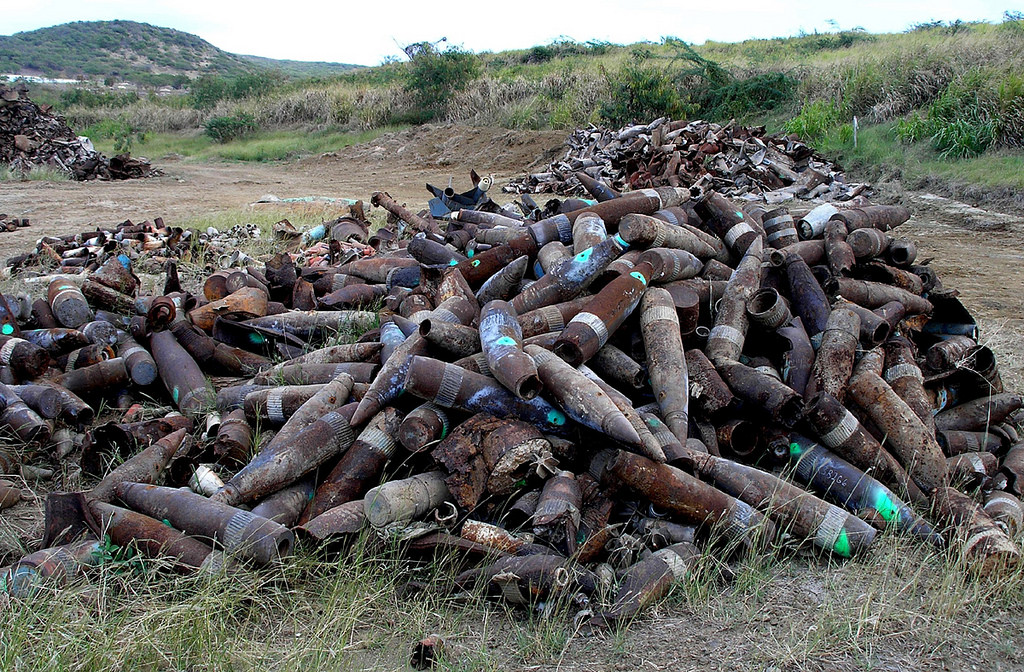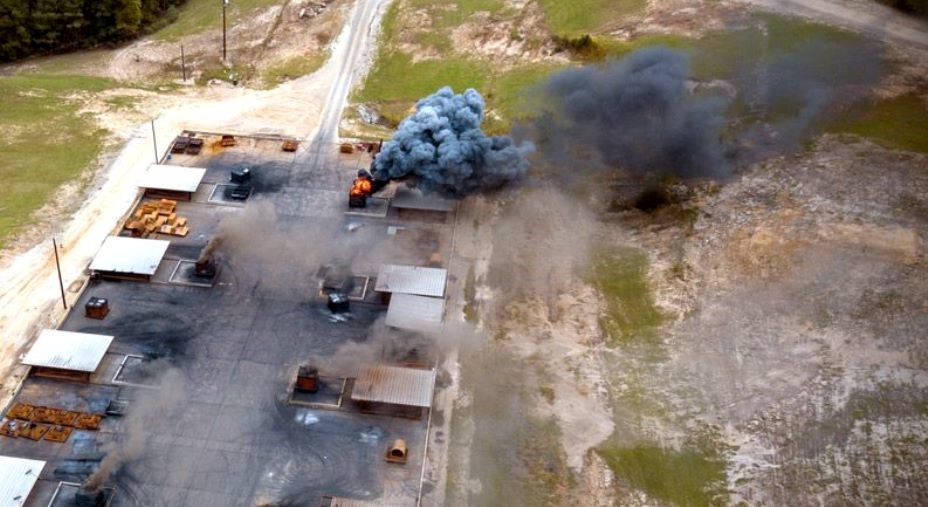If it feels like nothing has happened in the last few years in terms of cleanup at Badger Army Ammunition Plant – it’s because nothing much has happened. Seriously – we checked.
The Wisconsin Department of Natural Resources (WDNR), has not received any of the priority work products identified by the U.S. Army Corps of Engineers in 2020.
Still pending are: (1) an evaluation of active remedial alternatives for groundwater in response to increasing contaminant concentrations in nearby residential wells, (2) a work plan for the dredging and disposal of mercury-contaminated sediments at Gruber’s Grove Bay, and (3) an updated evaluation of monitored natural attenuation as a remedy for site-wide groundwater contamination.
Following is our update on the environmental challenges at Badger and other military bases in Wisconsin, and our national work to BAN open burning of munitions wastes — including toxic PFAS chemicals...
Badger Army Ammunition Plant
In August 2020, the Army Corps completed the first formal Five-Year Review of environmental conditions at Badger. The review focused on a number of hazardous waste sites including site-wide groundwater, Gruber’s Grove Bay on the Wisconsin River, and several landfills.
The review was conducted in accordance with a federal environmental law known as CERCLA – commonly referred to as Superfund. Per Executive Order 12580, the Department of Defense (DoD) is the lead agency when implementing CERCLA cleanup actions on DoD facilities, or where the sole source of an off-site release is from a DoD facility.
The purpose of the CERCLA 5-year review is to determine if the military’s cleanup remedy at each site is protective of human health and the environment.
Site-Wide Groundwater Contamination
There are four separate groundwater contaminant plumes emanating from Badger. Contaminants of concern include bromodichloromethane, carbon tetrachloride, chloroform, ethyl ether, nitrate, tarichloroethene (TCE), sulfate, 1,1,2-trichloroethane (1,1,2-TCA) and the explosive dinitrotoluene (DNT).
In 2017, Badger officials announced that the Army does not have the legal nor funding authority to authorize the construction of a public water system. The military is currently re-evaluating remedial options for the widespread groundwater contamination caused by past handling and disposal of hazardous waste at Badger.
Based on data gathered prior to 2018, the currently proposed remedy for groundwater includes monitored natural attenuation – a passive remedy that relies on natural processes such as biodegradation or dilution to meet environmental cleanup goals.
Since then, in May 2018, concentrations of the explosive DNT in groundwater at the former Propellant Burning Grounds (in the Town of Sumpter) climbed to 420.2 parts per billion (ppb).
Two years later, in April 2020, total DNT concentration skyrocketed to 1,286.9 ppb – more than 25,000 times above Wisconsin’s Groundwater Enforcement Standard of 0.05 ppb. DNT is a suspected human carcinogen and may damage the male reproductive system, the liver and kidneys.
Badger officials have suggested that an eight-foot rise in the water table in recent years may have moved groundwater above the estimated depth of contaminated subsurface soil, contributing to the massive release of residual toxic chemicals directly to groundwater.

The U.S. Army Corps Five-Year Review published in August 2020 recommended that the Army at Badger amend and expand its remedy selection analysis to include groundwater data that has been generated since 2018 and which reflects current site conditions. To date, this analysis has not been published.
The Army Corps also recommended an evaluation of active remedial alternatives for groundwater in response to increasing contaminant concentrations in nearby residential wells, particularly in the Town of Merrimac.
In September 2021, Badger officials reported the first-time detection of DNT in a residential well on Spear Road. This and other downgradient residential wells may be at risk if concentrations continue to increase in future groundwater monitoring events, the U.S. Army Corps cautioned.
Mercury at Gruber’s Grove Bay Still Exceeds Health-Based Goals
 During active production years, Badger Army Ammunition Plant discharged wastewater to Gruber’s Grove Bay of Lake Wisconsin resulting in the contamination of lake bottom sediments. Sediment contaminants include lead, copper, arsenic, ammonia, nitroglycerine, PCBs and methylmercury – the most toxic form of mercury. Mercury is a highly toxic element and there is no known safe level of exposure. Ideally, neither children nor adults should have any mercury in their bodies.
During active production years, Badger Army Ammunition Plant discharged wastewater to Gruber’s Grove Bay of Lake Wisconsin resulting in the contamination of lake bottom sediments. Sediment contaminants include lead, copper, arsenic, ammonia, nitroglycerine, PCBs and methylmercury – the most toxic form of mercury. Mercury is a highly toxic element and there is no known safe level of exposure. Ideally, neither children nor adults should have any mercury in their bodies.
The remedy at Gruber’s Grove Bay included sediment removal actions in 2001 and 2006. Based on data collected to date, including sampling results in February 2016, mercury concentrations exceed the cleanup goal for sediment throughout the bay.
The U.S. Army Corps Five-Year Review concluded that the remedy at Gruber’s Grove Bay is “not protective” because “high levels of mercury are still present following dredging that are above the cleanup goals and exposure is likely occurring.”
In order to assure protection of human health and the environment, “sediment dredging should be conducted to remove residual mercury concentrations above the cleanup goals,” the U.S. Army Corps said.
To date, future dredging has been proposed but no schedule or work plan has been submitted to the Wisconsin DNR.
HOW TO HELP: Click HERE to send an email message to WI Governor Evers, our U.S. Senators and U.S. EPA supporting mercury cleanup in the Wisconsin River at Gruber’s Grove Bay.
Construction and Demolition Landfills at Badger
 In 1988, the Army constructed Landfill 3118 to accept construction and demolition debris, asbestos, contaminated soil, and other wastes generated as part of base closure. In 2005, adjacent Landfill 3646 (photo) was constructed by the Army to safely dispose of nearly 1,400 contaminated buildings and structures that were slated for open air burning over a period of 10 years – a proposal that was abandoned in response to seven years of stalwart community opposition organized by CSWAB.
In 1988, the Army constructed Landfill 3118 to accept construction and demolition debris, asbestos, contaminated soil, and other wastes generated as part of base closure. In 2005, adjacent Landfill 3646 (photo) was constructed by the Army to safely dispose of nearly 1,400 contaminated buildings and structures that were slated for open air burning over a period of 10 years – a proposal that was abandoned in response to seven years of stalwart community opposition organized by CSWAB.
The remedy at Landfills 3118 and 3646 in the Town of Merrimac currently protects human health and the environment because “no evidence of current exposure exists and the caps limit future potential impact to groundwater through infiltration,” the U.S. Army Corps said.
WDNR officials agreed, saying that their main concern for any landfill would be if leachate is leaking into the groundwater and the data for these two sites doesn’t suggest either landfill is leaking. It also appears these landfills are being properly maintained and monitored by Badger, WDNR added.
Wisconsin’s Right to Regulate Military and Industrial Toxics Challenged
On April 12, 2022, the Waukesha County Circuit Court Judge issued a decision regarding the Wisconsin Department of Natural Resources’ (WDNR) authority to regulate emerging contaminants like PFAS as hazardous substances at military and industrial sites throughout the state.
In the case brought by Wisconsin Manufacturers & Commerce – the state’s largest business lobby – the court ruled that the WDNR lacked the authority to regulate PFAS chemicals because the Wisconsin Legislature had not yet established enforceable regulatory standards.
On June 7, 2022, the court granted the WDNR’s request for a stay of the decision for the duration of the appeal process. The stay allows the department to continue under the state’s long-standing Hazardous Substance Spill Law to work with responsible parties whose sites are contaminated by PFAS.
The stay also means that Wisconsinites with private wells contaminated with PFAS who are currently receiving emergency bottled water may continue to receive this source of safe drinking water while the department appeals the order.
Contaminants of emerging concern like PFAS are chemicals or materials characterized by a perceived, potential, or real threat to human health or the environment or by a lack of published health standards, according to the U.S. Environmental Protection Agency.

Emerging contaminants are of particular concern at military sites. For example, in addition to PFAS, the Department of Defense has identified munitions components like perchlorate, the explosive compound RDX, 1,4-dioxane, strontium and lead as examples of emerging contaminants that pose a risk to groundwater and drinking water.
Aqueous film-forming foams (AFFF) containing PFAS has been used by the military for over 40 years for suppressing liquid fuel fires, fire-training exercises and other emergency fire response activities. As a result of these activities, groundwater, surface water, and plants and animals in the vicinity of military installations have become contaminated with PFAS, some much more than others.
In July 2018, the U.S. Department of Defense identified eight (8) sites with known or suspected release of two PFAS compounds (PFOA and PFOS) in Wisconsin: Badger Army Ammunition Plant, General Mitchell Air Reserve Station, General Mitchell State Air National Guard Base, Madison Air Support Facility – Army National Guard, Fort McCoy, Truax Field State Air National Guard Base, West Bend Air Support Facility – Army National Guard and Volk Field Air National Guard Base.
Time to BAN U.S. Burn Pits at Home and Overseas
In communities across the U.S. and its territories, the Departments of Defense and Energy, NASA and private industry routinely open burn and open detonate (OB/OD) countless tons of hazardous munitions wastes in the open air. It continues to be the “standard method for disposal because it is a technically simple method of disposal that is frequently the least expensive and easiest to perform.” Despite the commercial availability of safer technologies, this devastating practice continues.
 In addition to PFAS, toxic emissions from OB/OD include explosives, elemental metals (e.g., arsenic, cadmium, chromium, cobalt, lead and mercury), volatile and semi-volatile organics, polycyclic aromatic hydrocarbons, chlorinated dioxins and furans, depleted uranium and perchlorate.
In addition to PFAS, toxic emissions from OB/OD include explosives, elemental metals (e.g., arsenic, cadmium, chromium, cobalt, lead and mercury), volatile and semi-volatile organics, polycyclic aromatic hydrocarbons, chlorinated dioxins and furans, depleted uranium and perchlorate.
PFAS are added to improve the performance and stability of military explosives and munitions. However, PFAS are not destroyed by OB/OD or incineration and are therefore dispersed to the air and the surrounding environment where they accumulate in people, as well as fish and wildlife. PFAS have been shown to affect growth and development, reproduction, thyroid function, the immune system, injure the liver and increase risk for certain cancers.
Pyrotechnic compositions of magnesium/Teflon/Viton (MTV), for example, are widely used in military flares and for igniting the solid propellant of a rocket motor, and are comprised of as much as 45% PFAS. The demilitarization of excess, obsolete, or unserviceable flares and other energetic waste currently relies OB/OD a practice that produces an ongoing uncontrolled release of PFAS and other toxic chemicals to neighboring communities and the environment.
Nonetheless, as recently as March 2021, the U.S. Department of Defense awarded two major manufacturing contracts totaling $500 million for “indefinite-delivery/indefinite-quantity” for MTV countermeasure flares to protect against infrared missiles.
According to EPA, approximately 225 treatment storage or disposal facilities (TSDFs) have or had OB/OD units in the U.S. Of the 225 TSDFs, 66 facilities were still operating under either interim status or a permit as of May 2022.
Sign the Petition to BAN U.S. Burn Pits at Home and Overseas at
https://cswab.org/cease-fire-campaign/cease-fire-petition/
Click HERE to make your tax-deductible gift to CSWAB – thank you!

